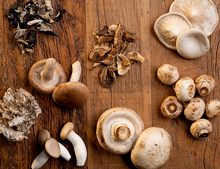Healthy, versatile mushrooms are an excellent addition to your plate. Mushrooms impart a fifth taste sense called umami, which is savory. Hearty meat-like mushrooms are an economical and nutritious way to enhance any meal.
Mushrooms are low in calories (one cup of raw sliced mushrooms has about 20 calories) and high in vitamins and minerals. A source of potassium, mushrooms can provide selenium and copper, depending on the variety. They have three B-complex vitamins: riboflavin, niacin and pantothenic acid, which help release energy from the fat, protein and carbohydrates in food.
Mushrooms also can be excellent sources of vitamin D if they have been exposed to ultraviolet light right before or after harvesting. Mushrooms provide plenty of opportunity in the kitchen. This is one vegetable you’re better off cooking as it releases more of the nutrients. Try grilling, stir-frying and sautéing to limit fat.
Choose mushrooms with a firm texture, even color and tightly closed caps. They can be refrigerated in a paper bag for up to one week, but they’re best used within a few days. Before preparing them, brush mushrooms off with your finger then rinse and pat dry with a paper towel (do not soak them). Some mushrooms, like shiitakes, should have their stems trimmed before cooking.
There are more than 2,000 varieties of edible mushrooms in all shapes, sizes and textures, but never eat mushrooms in the wild that you don’t know are safe — some are poisonous.
Agaricus (White or Button)
White button are the most common and least expensive mushrooms to appear on grocery store shelves. They have a mild taste and can be used in just about anything from salads to sauces. Button mushroom flavor intensifies when cooked, making them ideal for sautéing and grilling.
Chanterelles
One of the most commonly harvested mushrooms in the Pacific Northwest, chanterelles are funnel- or trumpet-shaped mushrooms with a fruity, apricot-like aroma and mild, peppery taste. Most are yellow or orange. Chanterelles pair well with herbs like chives and tarragon, are delicious sautéed or roasted and are a good substitute for pricier morel mushrooms.
Crimini (Italian Brown)
Crimini look similar to the white button, but are a little darker in color and have an earthier, stronger taste. They’re actually a young portabella and are sometimes called “baby bellas.” Criminis are good eaten raw, roasted or sautéed. Pair with garlic, thyme or balsamic vinegar for the best flavor.
Enoki or Enokitak
Enoki mushrooms are often used in Asian cuisine (particularly soups). They are long stemmed, white and have a delicate flavor and a slight crunch. Trim off the root end of the cluster and separate the mushrooms before serving. Enokis add crunch to salads and sandwiches, and mild flavor to soups and stir-fries.
Morel
Its honeycomb-like shape and intense, deep woods flavor add to the morel mystique. Varying in color from light yellow to dark brown, fresh morels are available (and hunted) in spring and summer. Accessible year-round, dried morels are full of flavor and much less expensive than the fresh variety. Cook before eating by sautéing, stuffing or simmering morels to create flavorful sauces.
Oyster
Oyster mushrooms are smooth, trumpet-shaped and have a light flavor. Though the color fades when cooked, oyster mushrooms can be yellow, pink or blue. Oyster mushrooms pair well with fish, seafood, poultry and red meat and are delicious simply sautéed or roasted whole.
Porcini
Porcini mushrooms are reddish brown in appearance. Porcinis are some of the most sought-after wild mushrooms for their distinct earthy, nutty flavor. Less expensive dried porcini can be reconstituted and used to add robust flavor to sauces, soups, stews and stuffing. Try them in a classic Italian risotto.
Portabella
A grown-up crimini, portabellas are large, firm and have a meaty taste and texture. With its steak-like texture, grilled portabellas make a satisfying vegan “burger.” Sauté, broil or roast portabellas and enjoy in fajitas, as a pizza topping or chopped into a hearty ragout. To prevent discoloration, remove the black gills before sautéing.
Shiitake
Shiitake mushrooms were originally cultivated in China and Japan. Like portabellas, shiitakes have a meaty texture. Cooking brings out their earthy, smoky flavor. With the tough stem removed, try shiitakes sautéed or add to stir-fries, soups or pasta dishes. For more intense flavor, try dried shiitakes in your recipes.

